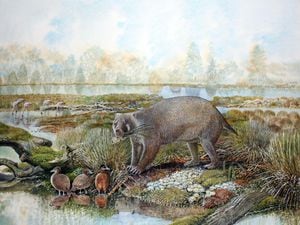Scientists discover extinct wombat-like species that lived 25 million years ago
The creature, named Mukupirna nambensis, was at least five times larger than living wombats.

A new wombat-like species that lived around 25 million years ago has been discovered in Australia.
Named Mukupirna nambensis, the “powerful beast” was at least five times larger than living wombats, about the size of a black bear, and weighed around 150kg (330lbs).
The fossil, consisting of a partial skull and most of the skeleton, was unearthed from Lake Eyre Basin of South Australia and is thought to be to one of the oldest known marsupials discovered in the country to date.
Researchers say their findings, published in the journal Scientific Reports, adds to the understanding of modern wombats and the evolution of their characteristic burrowing behaviour.
Pip Brewer, who is the Natural History Museum’s interim collections task force manager and one of the study authors, said: “Mukupirna reveals a fascinating mix of characteristics and provides evidence of a close link between wombats and an extinct group of marsupials called wynyardiids.
“It suggests that adaptations for digging for food may have existed in the very earliest members of the wombat family and likely led to their eventual survival to the present day.

“Although suggested previously, it had not been possible to test this, as the oldest fossil wombats discovered are only known from teeth and a few skull fragments.”
A team of researchers, which also included scientists from the University of Salford, analysed the anatomical features of the specimen.
They dated the fossil back to the late Oligocene period, approximately 25–26 million years ago.
Mukupirna, which means “big bones” in Dieri and Malyangapa – the Aboriginal languages spoken in South Australia, belongs to a new species of Vombatiformes, which includes Mukupirna, wombats, koalas and their fossil relatives.
Dr Robin Beck, a lecturer in biology at The University of Salford, who led the study, said: “Mukupirna is one of the best-preserved marsupials we know of this age from Australia.
“It tells us a lot about the evolution of wombats, koalas and their relatives.
“It is remarkable for its large size – this was clearly an impressive, powerful beast.”





